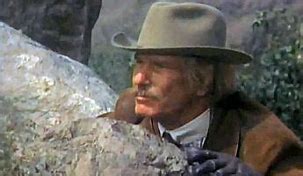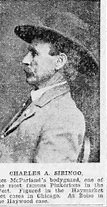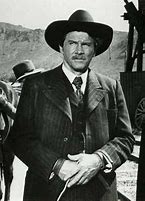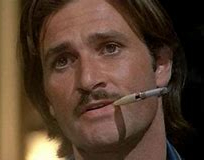 “All through the year we waited” as the song lyric goes, but in this case regarding Frontierado instead of Christmas. The first Friday of every August marks this holiday devoted to the myth of the old west rather than the grinding reality. For some of us the celebration kicked off Thursday night, for others they wait until the actual day of Frontierado to hold their festivities. Enjoy yourselves today and tonight, and enjoy the leftovers on Saturday and Sunday.
“All through the year we waited” as the song lyric goes, but in this case regarding Frontierado instead of Christmas. The first Friday of every August marks this holiday devoted to the myth of the old west rather than the grinding reality. For some of us the celebration kicked off Thursday night, for others they wait until the actual day of Frontierado to hold their festivities. Enjoy yourselves today and tonight, and enjoy the leftovers on Saturday and Sunday.
 CHARLIE SIRINGO – Like a real-life Harry Flashman of the American West, Charles Angelo Siringo, cowboy, bounty hunter and lawman, fought alongside or against some of the biggest names of his era. Siringo crossed paths with the likes of Billy the Kid, Wyatt Earp, Bat Masterson, the Wild Bunch, Tom Horn, Clarence Darrow, Kid Russell, Will Rogers, William Borah and many others.
CHARLIE SIRINGO – Like a real-life Harry Flashman of the American West, Charles Angelo Siringo, cowboy, bounty hunter and lawman, fought alongside or against some of the biggest names of his era. Siringo crossed paths with the likes of Billy the Kid, Wyatt Earp, Bat Masterson, the Wild Bunch, Tom Horn, Clarence Darrow, Kid Russell, Will Rogers, William Borah and many others.
Charlie was born February 7th, 1855 on the Matagordo Peninsula in Texas. In 1867 he began doing ranch work in whatever positions his youthful frame could handle. By April of 1871 he was working for Abel “Shanghai” Pierce as a full-fledged cowboy. Siringo went on to work on cattle drives throughout Texas, New Mexico, Kansas and Oklahoma (then called Indian Territory).

L.Q. JONES AS SIRINGO
In 1876 our hero rose to the position of trail driver and led his subordinate cowboys in herding roughly 2,500 head of Longhorn Cattle from Austin, TX along the Chisholm Trail to Dodge City, KS. Spring of 1877 found Charlie once again serving as trail driver from Austin to Dodge City.
On his trips to iconic Dodge City, Siringo had supposedly friendly encounters with the likes of Wyatt Earp and Bat Masterson and witnessed an altercation between a pair of Dodge City merchants and Clay Allison, the notorious gunfighter and bullying rancher.
While in Dodge City a few days after the 4th of July, 1877 Charlie signed on with David Beales and Deacon Bates to work in their cattle drive from their closing Colorado ranch down to the Texas Panhandle, where they were establishing THE legendary LX Ranch in what later became Carson, Hutchinson, Moore, Potter and Randall Counties in Texas.
On this cattle drive led by Trail Boss Bill Allen, Siringo met Owl-Head Johnson, the famed cattle drive cook and mess wagon driver. Charles and the others encountered buffalo herds and roughly 300 Apaches from Arizona. He would work for the LX Ranch for years.
Like any veteran of several years’ worth of cattle drives and cowboying, Siringo had already had assorted exchanges of gunfire with would-be rustlers. In 1880, when some LX Cattle were rustled during a jaunt in New Mexico, Charlie got to pursue the biggest rustler of them all, Billy the Kid.
The Kid and his gang had stolen the cattle, so Charlie Siringo joined up with Sheriff Pat Garrett’s posse pursuing Billy and his gang all the way through December of 1880, when Billy was captured. His appetite for that sort of action whetted, Siringo spent 1881 and 1882 bounty hunting and taking down active rustling operations.
In 1884 Charlie married Mamie Lloyd and gave up cowboying to open a store with her in Caldwell, KS. He also began writing his memoirs (At age twenty-nine!), little realizing the most active period of his life still lay ahead of him. Siringo’s autobiography A Texas Cow Boy; Or Fifteen Years on the Hurricane Deck of a Spanish Pony, was published in 1885 to much acclaim.
It proved so popular that in 1886 Charlie moved his wife Mamie and new-born daughter Viola to Chicago, where the ever-enterprising figure published a 2nd Edition partnered with Dobson Publishing. Siringo, his wife and daughter were rooming at a boardinghouse on Harrison Avenue when the May 4th Haymarket bombing and riot happened just a few blocks away.
 Outraged by this incident and longing for another change of career, Charles A Siringo went into the Chicago office of the storied Pinkerton Detective Agency on June 29th and applied for a position, listing Pat Garrett among others as references. Garrett replied back with a recommendation and the Pinkerton Agency hired Siringo. Charlie was delighted, but as the years went by, he would grow as disillusioned with the Pinkertons as Dashiell Hammett would decades later.
Outraged by this incident and longing for another change of career, Charles A Siringo went into the Chicago office of the storied Pinkerton Detective Agency on June 29th and applied for a position, listing Pat Garrett among others as references. Garrett replied back with a recommendation and the Pinkerton Agency hired Siringo. Charlie was delighted, but as the years went by, he would grow as disillusioned with the Pinkertons as Dashiell Hammett would decades later.
After some minor work regarding the aftermath of the Haymarket Affair, Siringo was assigned to shadow some banking officials suspected by their superiors of crooked behavior, investigated a missing persons case and recovered some stolen jewelry. Autumn of 1886 saw Charlie at last get his wish to be transferred west, and he was reassigned to the recently opened Pinkerton office in Denver, CO.
This was when Jefferson “Soapy” Smith was still the crime boss running Denver and much of Siringo’s detective work that winter involved exposing a few corrupt lower-level politicians in the Mile High City. He also corralled some of Soapy’s crooked street car conductors, who had devices for double-punching their rings, letting them charge the company for a much larger amount of work than they had actually done.
In the spring of 1887 Charlie was sent on a mission to deal with the Archuleta County Uprising, which involved vote fraud, then as now a thorn in the side of the electoral process. Next he spent 2 months pursuing a Wells Fargo stagecoach robber down into Mexico and from there to El Paso, TX and finally to the thief’s home in Leavenworth, KS where he had the police place him under arrest. While following the robber he kept a record of every purchase the man made with his stolen cash, as evidence.

Steve Forrest as Siringo
Not long afterward, Siringo and 3 other Pinkerton men were dispatched to Roseta, CO, where they broke into the Bassick Mine one night on behalf of the Agency’s client, millionaire David Bryan of Minnesota. There was a dispute over ownership and the well-armed and well-stocked Pinkerton 4 held off the Bassick & Associates’ men for several days, at one point reinforced by 2 hired gunmen from Silver Cliff, CO. In the end the courts did as David Bryan wanted, and appointed a custodianship over the mine while the legal battle raged on.
October of 1887 found Siringo assigned to work undercover on a ranch whose female owner had hired the Pinkerton Agency to gather evidence that the ranch’s foreman was working with her new partner to skim money from her.
Once that case was finished, our hero compiled an after-attack investigation report on the Ute Indian Meeker Massacre for the Pinkerton Agency’s biggest client – the U.S. Government. That investigation took place in White River and Milk Creek, CO during the Ute War.
During the winter of 1887 into 1888, Charlie Siringo was assigned to infiltrate a gang of wanted fugitives who were passing themselves off as honest ranchers in Wyoming at a spread called the Keeline Ranch.
This was a particularly dangerous undercover mission because the rival Rocky Mountain Detective Agency had already lost three of their operatives who tried to infiltrate the gang. Led by Tom Hall, the Keeline Ranch outlaws were shrewdly suspicious of newcomers and had, one after the other, sniffed out and lynched the RMDA men, leaving them to be found dead dangling from tree branches.
Given Wyoming winters, the gang was basically hunkering down until they could resume activities in the spring. Siringo rode into the area and used clever multi-layered false identities to convince the outlaws’ friends in the area that he was a fugitive himself.
Beginning at the Roundup Number 5 Saloon, an establishment friendly with the Keeline Ranch desperadoes, Charlie ran a masterful deception in which his surface identity of Charlie Henderson was meant to be seen through, with any digging by the gang resulting in them finding out that he was “actually” a real-life fugitive gunman named John Pumphry.
“John Pumphry” was a closed case from the Pinkerton files, a killer who had fled the country years earlier, so Siringo could be fairly confident that the gang would not know that and would accept that he really WAS Pumphry using the alias Charlie Henderson. Tom Hall and company bought it and our hero spent the winter partying hard with the gang, all the while compiling information and covertly getting it mailed off to his superiors in Denver from time to time.

Should have played Siringo
While posing as Pumphry, Charlie also unearthed a lot of hot bonus information that was not of any particular use to the Pinkerton Detective Agency for any of its current cases but might be useful in the future.
Among that intelligence was the name of a criminal who, for $500, would break arrested outlaws out of city or county jails via hacksaws concealed on his person like a spy. Under false names he would get himself jailed in the same slammer as the target his clients wanted busted out, then use his concealed tools to get them out, with anyone else in the cells welcome to escape, too.
Other information involved a fugitive network running from western states to New Orleans, LA, where outlaws paying their way along that network would be taken by ship to Buenos Aires, Argentina to work in outlaw gangs in that country. (Talk about aggressive recruiting!)
Shortly before spring arrived, Siringo managed to slip away and reach Cheyenne, WY, where the Pinkertons’ client, the D.A.’s office run by Kalter Skoll, was located. Charlie’s testimony to the Grand Jury, backed up by his filed reports, succeeded in getting that Grand Jury to issue arrest warrants for all of the Keeline Ranch Gang that the detective had been able to identify. Wyoming lawmen then surrounded that ranch in great force and brought in the outlaws.
Next up for Charles Siringo was catching the Denver & Rio Grande train robbery gang of the Smith Brothers (and one sister), followed by a big shakeup at the Denver Field Office. Siringo later said he did not trust a lot of the other operatives at the Denver office of the Pinkerton Detective Agency and had written a friend that he considered the atmosphere there to be as deadly as when he was out in the field.
Charlie’s instincts proved rock-solid, as 1888 saw a Pinkerton Home Office corruption investigation of the Denver fiefdom of the office Chief (called only “Superintendent A” in Siringo’s memoir). That man was found to have been offering all manner of extra services to Denver officials under the Pinkerton flag but keeping all the charged money for himself and his equally corrupt subordinates.
“A” and his cronies were fired and replaced. James McCartney, a man that Charlie came to admire, replaced that corrupt administrator after running the investigation that rooted out “A’s” misdeeds.
After that, Siringo was assigned to go undercover in the “Paddy Mack (Patrick McNamarra)” Gang of ore thieves. The client was the Aspen Mining & Smelting Company, a silver mining company that was losing a lot of its ore to Paddy and his gang. When Charlie was through the gang and their fences had all been brought down and Paddy himself was dead.
And so it went, year in and year out. Naturally, assorted cases resulted in dead ends, but for the purposes of this Frontierado item I’m focusing on Siringo’s cases which had definitive outcomes.
Mamie Siringo passed away in 1890 and Charles sent their daughter Viola to be raised by his late wife’s aunt and uncle.
February of 1891 saw Charlie assigned to an investigation on behalf of Pinkerton’s new client New Mexico Governor L Bradford Prince. For 6 months the detective looked into the attempted assassinations of politician Thomas Catron, University of New Mexico President Elias Stover and others.
Siringo’s investigation was unearthing evidence involving everyone from the Santa Fe Ring of corrupt landowners & lawyers to the populist Las Gorras Blancas movement. Obviously powerful people didn’t like where any of this was headed and the client shut down the investigation before Charlie could prove any culpability. Not wanting his New Mexico sojourn to be a complete waste, the detective bought 265 acres of land to establish his Sunny Slope Ranch near Santa Fe.
In 1892 our hero was sent to Idaho to investigate corrupt union officials on behalf of their management opposition, the Idaho Mine Owners Protective Association. At the end of this 14 month investigation Charlie’s evidence and testimony helped put 18 of the criminals in prison.
Siringo married again in 1893, this time to Lillie Thomas, with whom he had a son William in 1896. They divorced when Lillie was insistent on moving to Los Angeles, but Charles did not want to go. She took their son with her.
It was in the 1890s that Charlie met lawman Joe Lefors and Tom Horn, the gunfighter and future killer for hire, who was also working as a Pinkerton Detective. Siringo wasn’t shocked by Horn’s later troubles, since he judged the man to be amiable but with a dark side to his personality.
Come 1899 and Charlie was assigned to the Pinkerton Squad hired by “Mr E.H. Harriman of the Union Pacific Railroad” to chase Butch Cassidy’s Wild Bunch faction of the Hole In The Wall Gang. That stellar outfit also featured Joe Lefors, Lord Baltimore and others. While working undercover at one point as a criminal named Charles L Carter, Siringo met and interacted with Butch, the Sundance Kid, Kid Curry and other members of the gang.

Franco Nero should have played Siringo
Over the next 4 years our hero was able to obtain crucial intelligence to arrest some lesser gang members and to disrupt their elaborate methods of communication (including “drop-hole” mail locations) but the only big name that Siringo landed was Kid Curry (who later escaped prison).
In 1907 Charlie’s growing disillusionment with the Pinkertons’ methods against labor unions and striking miners hit the boiling point. He was assigned as the bodyguard for the prosecution’s State’s Evidence witness Harry Orchard (real name Albert E Horsley) in the Idaho trial of Big Bill Haywood.
Orchard had confessed to killing 17 people during the Idaho Labor Unrest, including the bombing murder of former Governor Frank Steunenberg. Orchard had turned State’s Evidence and was testifying that he had been hired to kill Steunenberg at the behest of 3 labor leaders, including Bill Haywood.
The Haywood Trial began on May 9th, 1907 and ended on July 29th. Famed defense attorney Clarence Darrow was part of the legal team defending Haywood. During the trial suspicions were raised that Orchard had really killed Frank Steunenberg over his own grievances with the late governor, and was being “put up to” implicating labor leaders who were foes of many of the Pinkertons’ clients.
Siringo fulfilled his bodyguard duties to keep Orchard alive during the trial but when Haywood was acquitted on July 29th, a turning point was reached. During the trial’s testimony the detective may have had some suspicions he had about his employers confirmed. He then thwarted an attempt by unnamed “anti-labor forces” to kill Clarence Darrow, Bill Haywood and the other 2 labor leaders that Orchard had accused of hiring him – Moyer and Pettibone. Soon after, Charlie resigned from the Pinkerton Agency and married his new wife, Grace.
In 1909 Charles and Grace divorced, and he worked a few cases for the William J Burns Detective Agency. Then he moved to his Sunny Slope Ranch in New Mexico, where he wrote a lengthy book about his experiences with the Pinkertons.
The Pinkerton Agency’s lawyers took action to prevent the book from being published, claiming it violated the confidentiality agreement that Siringo, like all Pinkerton operatives, had signed at the start of his employment. The Agency had its lawyers take such swift action against Charlie because in 1907 Morris Friedman, another former Pinkerton employee, had published his book The Pinkerton Labor Spy, which had already given the Agency a major black eye in terms of public image.
With the famed Charles Siringo now authoring another tell-all book of his own it looked like exposes by former Pinkerton men might become what the spurt of exposes by former CIA men was to the 1970s. The Pinkerton organization acted to shut off the flow of revelations about its questionable methods of operation.
The legal proceedings dragged on for years and in the end Charlie was only allowed to publish the book with the Pinkerton name changed to Dickenson. Other parts of the book also had to use pseudonyms as a condition for publication. Assorted place names and dates also had to be redacted, but in the end A Cowboy Detective was published in 1912.
In 1913 Charlie married again, this time to Ellen Partain, but his marital track record remained unbroken and the pair soon divorced.
Boiling with anger over the legal battles with the Pinkertons, in 1915 Siringo privately published a much more explosive account of Pinkerton activities and influence. While also attacking the dangers of Anarchists, the book, titled Two Evil Isms – Pinkertonism and Anarchism, claimed that Pinkerton agents participated in much scandalous and illegal conduct on behalf of their monied and powerful clients. Among those activities: having Pinkerton operatives engage in vote fraud by voting many, many times under different names for the candidates favored by those clients (which, if you’ll recall, included the U.S. government).
The Pinkerton organization hit the roof! Through their lawyers they made it so that it was against the law for many years to sell any more copies of the book. They also wanted to take legal action against Charles Siringo personally, but New Mexico Governor William C McDonald blocked their extradition attempts against Siringo.
The year 1916 saw Charlie become a New Mexico Mounted Patrolman at the age of 61. He oversaw their efforts against the lingering rustling activities in the state until 1918, when his health forced him to retire. He moved to Los Angeles, where, like many Old West heroes of the past he became popular among entertainers like silent film western star William S Hart, comedian Will Rogers and others.
During the late Teens and the Roaring Twenties Siringo even hung around with fellow Old West icons Wyatt Earp and Kid Russell, who was now a world-famous artist. Charlie sold his New Mexico ranch because he needed the money, and he also worked as a consultant on a few silent movie westerns, including William S Hart’s classic 1925 film Tumbleweeds.
 Siringo had a bit part as an aging cowboy in the 1924 movie Nine Scars Make A Man and possibly others which are among the countless silent films lost forever. He also penned two more books, History of Billy the Kid (1920) and Riata and Spurs (1927). In 1919 he had published a pamphlet collecting many of the old (as in 1870s and 1880s) cowboy songs that men like him had actually sung to cattle to calm them. It was titled The Lone Companion of a Lone Star Cowboy.
Siringo had a bit part as an aging cowboy in the 1924 movie Nine Scars Make A Man and possibly others which are among the countless silent films lost forever. He also penned two more books, History of Billy the Kid (1920) and Riata and Spurs (1927). In 1919 he had published a pamphlet collecting many of the old (as in 1870s and 1880s) cowboy songs that men like him had actually sung to cattle to calm them. It was titled The Lone Companion of a Lone Star Cowboy.
Charles Angelo Siringo passed away in Altadena, CA on October 18th, 1928, and was buried at Inglewood Park Cemetery.
FOR DANITES: GUN-SLINGING “KNIGHTS” OF THE OLD WEST CLICK HERE.
FOR THE WILD TIMES IN LAS VEGAS, NM CLICK HERE.
FOR THE WILD TIMES IN SIDNEY, NE CLICK HERE.

Reblogged this on El Noticiero de Alvarez Galloso.
Thank you again! I will reblog another SOSCuba post within the next few days!
Thanks. We need to make public Cuba since many here in America who want Democratic Socialism actually want America to be another Cuba.
I know exactly what you mean!
Happy Frontierado Day! 😉
Thank you! Same to you!
🙂
😀 😀
Cool to shed light on the otherwise unknown (to most).
Thank you very much! I try!
I love sagas like this! The days of rugged individualism were killed by politicians.
I know what you mean!
I really like this post’s true crime and old west going on.
Thanks! I certainly understand!
Good one!
Thank you very much!
I want movies and more about this man! HAIL BALLADEER’S BLOG!
Thank you!
A paisan western hero! Love it!
I understand.
We need men like this today instead of weak men like Biden.
Could be!
I could go for a lot more Siringo!
I understand!
Gioielli italiani in vendita online ai migliori prezzi direttamente dai laboratori orafi di Valenza. Acquista il tuo gioiello su cosmoos4you.com.